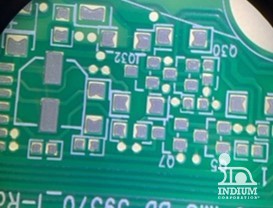Recently, I hosted a webinar for Stencil Printing 101. The InSIDER Series contained two parts. The first is on the basics: Solder paste 101 – the history of stencil printing and what it is, printer setup, and important parameters to consider for stencil printing. The second part is a more in-depth look at solder paste printing. Part II included: Best practices for stencil printing as well as storage and handling, common defects that occur during printing, and some useful design of experiments (DOEs). If you missed either webinar, you can view these as well as other archived recordings here.
Due to time constraints, we could not respond to all submitted questions. My team and I have since reviewed and responded to those questions below:
Q: What is lowest pitch that stencil printing works?
A: The pitch of apertures depends on manufacturability, paste, stencil, etc. For pitch, you will want to look to the IPC standards; they should give you guidelines on design. One test in particular that is relevant to solder paste is the Solder Paste Slump Test (5-24b - TM650: 2.4.35).
Q: Are there any special considerations for flex circuits; for instance, when there are stiffeners present?
A: For flex circuits, it’s important to make sure they are supported sufficiently during the printing process. If there is concern about stiffeners or other materials and their compatibility with the solder paste, then testing should be done.
Q: Is there any flux residue after reflow which might affect the underfilling process? Do we need post reflow cleaning?
A: There is indeed flux residue after reflow. Materials can interact, so it would be best to test the compatibility between the materials. If you are concerned about interaction, post cleaning of the residue is advised.
Q: What is an acceptable abandon time for a no-clean, lead-free solder paste?
A: We test our materials for abandon times. If possible, it is best to avoid abandon time, but materials can be left for a couple of hours. Best practice would be to not introduce this, though sometimes it is unavoidable. Depending on the factory conditions, it might need recovery prints.
Q: When you have humidity at 20% and below, can you guess how much that affects the stencil life?
A: It can affect the stencil life of the material. At a lower level of humidity, volatiles could come out of the paste. It would be more so for water-soluble materials. However, it can affect and dry out no-clean materials as well. This could reduce the stencil life of the material.
Q: What actually happens when the PCB separates from the stencil: Does the PCB drop down, does the stencil lift up, does only one item move while one item is fixed?
A: The stencil doesn’t move – the rails along with the clamps move the board away from the stencil. The stencil does move in the alignment between the board and the stencil, though not significantly, and in the X-, Y-, and theta direction.
I thank everyone again for attending and recommend that you check out our other archived webinars on our website. If you have additional questions about the presentation or anything solder related, please don’t hesitate to reach out to askus@indium.com.


